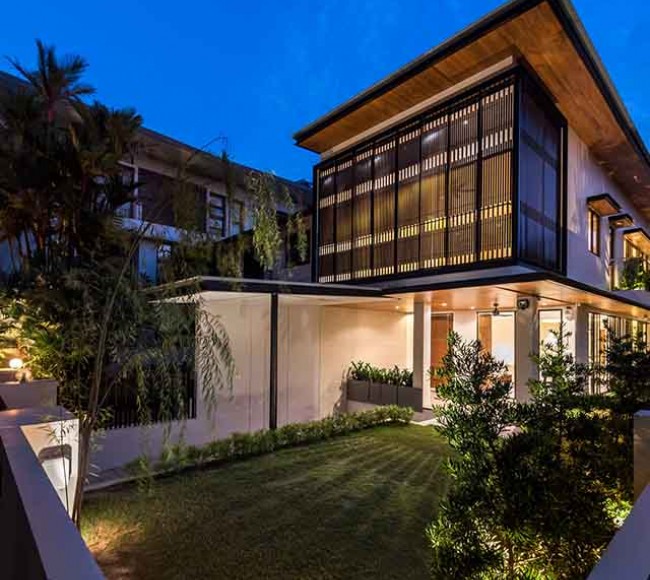
Stepping into a house invigorates our senses instantly.
The sights, sounds and smells greet us openly. Our thoughts start to form. Our comfort levels and mood may oscillate between good and bad. Having an overall pleasant experience is paramount as not only is the home a place we spend many hours in, but it is also the place that is filled with intimate moments with family, the place for peaceful rest, rejuvenation and inspiration even. Architects strive to design homes that are not only functional but more importantly, serve as comfortable abodes for people to live happy, healthy and comfortable lives.
Studies have shown that people react negatively to simple, dull home designs. Even if functional at most levels, they do not provide that comfort and warmth expected of a cosy abode.
Instead, exciting and unique designs often elicit positive responses, resulting in overall positive well-being.
Colour is an important cog in the wheel of design. Visual stimuli contextualized by colours have an extraordinary ability to affect moods and behaviours. The impression of a colour and the message it conveys is of utmost importance in creating the psychological mood or ambience that complements the function of a space. For example, it is well-known that blue has a calming effect, yellow is associated with cheerfulness, orange and red are striking while green is perceived as more relaxing and tranquil. Using different shades of colour add a further layer of dexterity in using the colour palette. Pastel shades exude nuanced undertones while solid colours portray strength and clarity.
Daylighting is another important factor in house design. Through intelligent positioning of windows, subtle openings, air wells and other reflective surfaces, sunlight (direct or indirect) can be captured to provide effective illumination. Done right, lighting has the effect of visually enhancing any given space or surface, bathing the house in a warm glow. Ample use of natural lighting also furthers the energy efficient cause. Researchers have found that a well daylighted space can also have a positive physiological impact on a person’s circadian rhythm. Otherwise known as the “body clock,” the circadian rhythm is an internal cycle that tells our bodies when to sleep, wake up and eat and is primarily triggered by the body’s response to light and darkness. As demonstrated by filmmaker Bong Joon-ho in the Oscar winning movie, “Parasite”, light is an important element that is often perceived as instrumental to a better quality of life.
Another element that impacts our mood, behaviour and health is having access to greenery. Within the confines of a home setup, gardens, outdoor play areas or simply some potted plants can serve this purpose. Besides being aesthetically appealing, having greenery around the house compound helps bring the outdoors in, “softens” the glass, steel and cement environment commonly seen in most houses and can be helpful in lowering depression and anxiety levels leading to improved overall health.
Ergonomic considerations enable designers to design surroundings to be better suited to the human form as well as take into account the specific needs of the home occupants. For example, occupants on mobility-assisted devices such as wheelchairs, appreciate wider doorways and lowered kitchen countertops. In these instances, good design transcends ergonomics, to imbue safety consideration. Mobility, independence, safety are seamlessly married through good design.
Sustainability – mantra of the modern-day lexicon, is a key offshoot of good design. Incorporating sustainable design elements in a home not only aids the conservation cause through smarter usage of Earth’s precious resources but increases the health and comfort of the occupants, enhancing mental and physical wellbeing and optimising user experience in built environments.
Clearly, well-designed residential layouts provide flexibility and integrates the needs of its occupants to create well-functioning and responsive space solutions that enhance the quality of life of its dwellers, making for an overall better living experience. A thoughtful kitchen layout enables a good flow for daily chores. Completion of daily chores will be much easier and more efficient. Instead of for single-purpose use only, space can be intelligently designed for multiple uses, particularly so in the pandemic age where many have found the need to harmonise a newfound need for a work space within the home. Space designed for multi-function uses allows for flexibility and ease of transition as users’ expectations and demands change and evolve. Not only is efficiency of space maximized, it broadens appeal by catering to multiple users who may have differing needs at different times. This prolongs the usable lifespan of a dwelling and ensures its reuse by future owners.
Design, at its core, is an artistic expression. Yet it is powerful enough that married with smart ideas, it ultimately transforms a house for staying into a home for living.
Talk to us today to see how great ideas can make a difference.